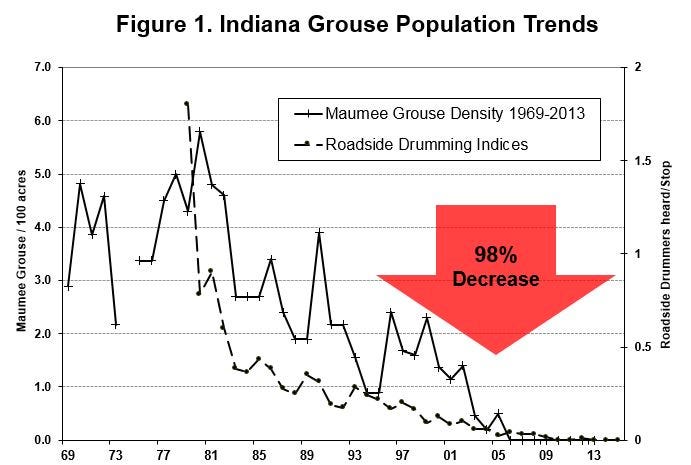Save the Ruffed Grouse !
Cut down a forest today ! (Sarcasm, Duh !)
Below is a picture of the Ruffed Grouse seen in the Hoosier National Forest in Brown County Indiana. Isn’t he cute? The grouse was pointed out by a birder extrodanaire from Indianapolis, Aidan Rominger, who had driven down to try to spot it — guess they haven’t been seen for over 2 years in these parts.
And there below you can see him as he followed me down the trail (just below and to the left of my left foot).
I even saw one on my deck when I was putting out corn, sunflower seeds, and black walnuts for the birds and squirrels, but didn’t get a picture of it there.
This is a very friendly bird! He just hung around, pecking at our shoes while we took pictures of him, and then he followed me down the trail. A friend told me a story how one of these birds sat on the end of someone’s shotgun for a long while they were hunting (not for Ruffed Grouse).
The Ruffed Grouse has been taken off the Indiana hunting list because there aren’t any to hunt. From a 3 year old article:
According to the IDNR Wildlife Science Report (2017), the 2017 statewide drumming survey in Indiana reported zero drumming grouse on 14 different roadside routes for the fifth year in a row. Further, only one grouse has been heard over the past seven years during these surveys.1
Nowadays, if someone from Indiana wants to hear a grouse drumming, their best bet is to hop in the car and head [North] to Michigan or Wisconsin.2
Now, I know what you’re thinking: Global Warming (that Religion, not Science, that can explain everything and predict nothing) !
NOT.
It is rather loss of habitat, but not in the way you probably think. Ruffed grouse depend on young forests of seedling/sapling/pole size hardwoods. Historically, this habitat formed from natural disturbances such as tornadoes, fire storms, and insect outbreaks, or occurred in transitional zones between grasslands and forests.3 100 years ago, most of the hardwood forests in the hills of Southern Indiana had been cut down, but most of the land was not suitable for agriculture. The Great Depression sealed the fate of the small farmers in south central Indiana. After 100 years of wear on land never suitable for farming, the steep hills were eroding; and the soil was depleted of nutrients ... As many of the farmers moved out in the 1930's, generally just abandoning their farms and homes, local officials became concerned about the growing amount of tax delinquent lands on the tax rolls.
Indiana's governor, Paul V. McNutt, and the 73rd Indiana Congress in June, 1934, asked the Forest Service to buy this land for the eventual creation of a National Forest.4. Today the Hoosier National encompasses over 300 square miles and I am lucky to live on some private land in the middle of this forest, a legacy of some landowners (the Fleetwoods5) who did not sell their land to the U.S. government, but stuck it out. Today some of these forests are nearly 90 years old and are beginning to mature, resulting in a the loss of habit for the Ruffed Grouse, and the restoration of habit for many other birds, amphibians, and furry animals.
https://ruffedgrousesociety.org/reversing-ruffed-grouse-declines-in-indiana/
https://www.backcountryhunters.org/the_decline_of_indiana_s_ruffed_grouse
https://secure.in.gov/dnr/fish-and-wildlife/wildlife-resources/animals/ruffed-grouse/
https://www.fs.usda.gov/detail/hoosier/learning/history-culture/?cid=FSEPRD576369
“Hippies” from Gary, Indiana bought this land from the Fleetwoods to build some houses in the late 60’s or very early 70’s during the Vietnam War. They built a Hexagon where they all lived together, and then a Pentagon, a Pyramid, and an Octogon house; I live in the Pentagon built by Greg and Leah Hoffman in the early 70’s. I’ve seen many gravestones with the name Fleetwood in the old Deckard Cemetery which dates back to 1854.




I stand corrected: when we saw the Grouse we were in the Yellow Wood State Forest ...
Donations to support the upkeep of the very beautiful and peaceful Deckard Cemetery can be sent to:
Jeannie Deckard, 4725 E. State Road 46, Bloomington, IN 47401